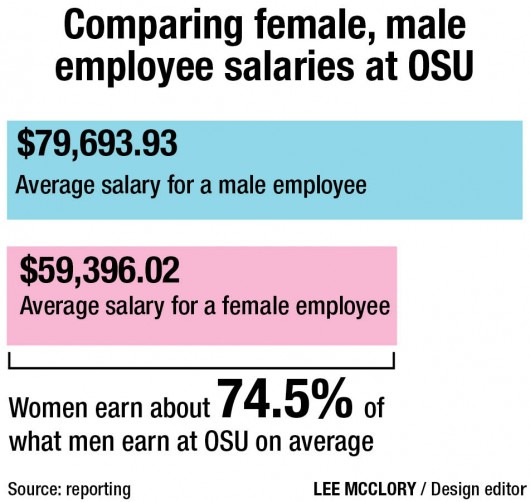Despite university diversity initiatives, the presence of female leaders — especially women of color — remains low.
Hazel Morrow-Jones, director of The Women’s Place, associate provost for Women’s Policy Initiatives and a professor of city and regional planning at OSU, said she is pleased that the portion of female faculty has continuously improved since The Women’s Place started 15 years ago.
The Women’s Place is an office at OSU that “serves as a catalyst for institutional change to expand opportunities for women’s growth, leadership and power in an inclusive, supportive and safe university environment,” according to its website.
But it seems there is still work to be done.
Female faculty are most prevalent in lower-level positions within in the university, Morrow-Jones said.
Referencing The Women’s Place’s “2014-15 Status Report on Women at Ohio State,” a report on the status of women to show the progress in OSU’s gender equity, Donna Bobbitt-Zeher, an assistant professor of sociology with a focus in gender inequality who teaches at OSU-Marion, said the roles women occupy at OSU are consistent with trends seen nationally.
“Many of the patterns in the report are illustrative of larger patterns in workplaces across the country,” Bobbitt-Zeher said in an email.
For example, the portion of female assistant professors (48 percent) is closer to being equal than the portion of female full professors (25 percent). This follows national trends because higher status, higher paid jobs are predominantly held by men, Bobbitt-Zeher said.
There are some external reasons for those trends.
Molly Cooper, a senior lecturer who teaches a course in the economics of gender in labor markets, said the responsibility of taking care of children or aging parents is usually taken on by women, so women are more likely to work less hours than men.
“In fact, one very recent (study) shows that women under 30, living in urban areas who have never had a child make more than their male counterparts. The overall gender gap has really become a ‘Mommy Gap,’” Cooper said.
At least one student said she wasn’t happy to see the figures in the OSU status report.
“It is really frustrating to see these numbers,” said Taylor Price, a third-year in environmental engineering and president of the OSU chapter of the American Association of University Women.
Price added that she was surprised a large institution like OSU doesn’t have more equality in its workforce.
“Their records are public. Everybody can see this, so you would think they would be kind of more accountable,” she said. “I just think equality is something that we need to strive for, and it’s difficult, and it’s a struggle, and it’s especially frustrating that it has to be so difficult because it’s a difference in gender — it’s not a different species.”
Leadership concerns
Deans and department chairs are two areas that Morrow-Jones said she thinks need improvement as far as women leadership is concerned. Women account for 30 percent of deans and 16 percent of named chairs, according to the report.
“Department chairs are so important because they really create the climate for everybody in an academic department — so the faculty, the staff and the students. So, if the person who is in charge of the department, the department chair or the school director, is really aware and on top of these kinds of (diversity) issues, then they make the place welcoming for everybody,” Morrow-Jones said.
Price said that while she understands the difficulty in cultivating women leaders, the situation is discouraging to see as a student.
“It definitely doesn’t spark my interest to go into higher education,” she said.
Women of color
Since 1999, there has been a 0.1 percent increase in the proportion of black women faculty at OSU, according to the 2014-15 status report.
The under-representation of black people at universities — both men and women — might be a national problem, though. Black people who held full-time faculty positions accounted for 4.2 percent of the faculty population in higher education in 1981 and increased to 5.6 percent in 2003, according to the U.S. Department of Education.
“At this rate of improvement, it will take more than 180 years for the black faculty percentage to reach parity with the black percentage of the U.S. population,” according to “Recruiting the Next Generation of the Professoriate,” a Peer Review article from 2010.
Asian-American women make up 4.9 percent of total faculty at OSU — a 3.5 percent increase since 1999, according to the 2014-15 status report. Hispanic women saw a 1.1 percent increase during those years, making up 1.4 percent of total faculty.
American Indian and Hawaiian women each make up 0.1 percent of total OSU faculty, and women of two or more races account for 0.3 percent, according to the report.
Two women of color held two of the total 21 provost positions in 2014, according to the status report.
Salaries by gender
The average salary of an OSU male employee was $79,693.93 and the average salary of an OSU female employee was $59,396.02, according to data provided by OSU’s public records office that contained regular, non-student employees with 50 percent or more full-time equivalents as of late 2014.
The typical gender pay gap is widely reported as women making 77 or 78 percent of what men earn. According to the numbers above, the OSU statistic would be about 74.5 percent.
Because this is close to the national statistic, Bobbitt-Zeher said she is not surprised by the numbers.
“One of the dominant explanations of the gender income gap is that men and women tend to work in different occupations and the ones women tend to work in are paid less than the ones men tend to work in,” she said.
Cooper, the economics senior lecturer, said in an email that the reason for the lower percentage might be because the data does not include employees with less than 50 percent full-time equivalent, which is the ratio of the number of paid hours to the number of working hours in a set period.
Personally, Cooper said she has two children and finds her job as an instructor to be “very compatible with raising children.” When she finished her Ph.D., she had one 9-month-old child and one child who was just turning 4 years old.
“The publishing requirements of a tenure track position was not something I felt I could take on at that time, and I have found this position to be what is best for me and my family,” she said.
Cooper said she thinks OSU has good programs to support women with children, such as an on-site child care center and summer camps for school aged children.
“They should continue to find ways to assist working parents, especially mothers, pursue the careers that best meet the needs of their families,” she said.
During Morrow-Jones’s time with The Women’s Place, she said she has seen a shift in views, but now it’s time to make a change to the system.
“When I first came in here, there was more of a sense of women need to change. Women need to learn how to do x or y or z, how to negotiate, how to do this. And there’s still some of that, and, you know, everybody can always learn. That’s fine. But the sense that I have now is there’s plenty of women out there that are absolutely ready,” she said.
“Now it’s not a question of there aren’t any women to do this. Now it’s a question of, ‘How do we fix your selection processes, because you’re not picking the women who are there to do it?’”
This is the first of a two-part series on gender at Ohio State. The second part will look at the initiatives in place to promote diverse faculty and leaders and cultivate a positive environment for those individuals.




